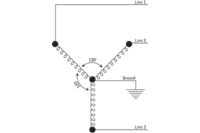
(My March 3, 2003 column dealt with the secondary windings of a Delta service transformer, showing that power-leg or wild-leg voltage is 208 V with respect to ground. It also mentioned that this 208 V should not be confused with the 208 V coming from the secondary Wye service transformer.)
This article will deal with the secondary windings of the Wye service transformer.
Wye service is probably one of the most popular service drops in medium-size commercial buildings. This dual-voltage, three-phase service delivers four wires to the building. There are actually three 120-V windings, which are 120 degrees apart (Figure 1). They consist of three hot wires and a neutral or “ground.”
The secondary winding of the Wye is center-tapped and grounded. This makes the center tap, or ground, perfectly symmetrical to all three phases of its power.
There is no “wild” or “power” leg in the Wye configuration, as there is in the Delta transformer’s center-tapped secondary (described in the March 3 article).

Voltages
Wye service can be used for three- and single-phase applications. Single-phase voltages can be picked off of the Wye secondary (Figure 2). Listed here are those single-phase voltages:As we can see, 120-V single-phase, 208-V single-phase, and 208-V three-phase power can be had from the Wye when it is center-tapped to the ground. The 208-V three-phase power comes from the use of all three power legs, A, B, and C. If the Wye were not center-tapped to ground, no low-voltage (120-V) single-phase power would be available. However, 208-V single-phase and 208-V three-phase power still would be available without the center-tap. The 208-V single-phase power would come from any two power legs — A and B, B and C, or A and C (Figure 2).
It can be said that any two of the three windings of the Wye secondary are in series with one another (Figure 2). However, remember that power surges of the inducted voltage that come from the primary windings to the secondary windings are not in phase with one another. In fact, each phase is 120 degrees out of phase with one another (Figure 3).
When one phase is positive and maximum voltage, the voltages of the other phases or windings may be negative and less than maximum. The phenomenon makes the voltage between any two conductors to be 208 V and not 240 V (120 V x 2) (Figure 2).

Loads
Notice that the neutral or ground wire is connected to the center of the Wye, which makes it perfectly symmetrical. The voltage between any phase (A, B, or C) and neutral (N) will be 120 V.Since there is no wild leg or power leg as in the Delta service transformer, all 120-V, single-phase loads may be connected to N and any of the three power wires, A, B, or C, without worrying about “burning them out” from too high of a voltage.
To balance the loads, all single-phase loads should be equally spread between the three secondary windings.
Higher Voltages
If the turns of wire of the secondary windings are increased, a higher voltage will be induced into them from the primary windings of the service transformer. Often, each phase of the Wye transformer will deliver 277 V instead of 120, and the voltage between any two phases is 480 V instead of 208.The advantage of the higher voltage is to reduce the amperage for a given amount of power. Line losses are reduced and wiring size can now be reduced because of the lower amperage flow. Even electric motors can be made lighter because of the higher voltage causing a smaller wire size.
The 277 V is often used for lighting in commercial and industrial buildings. The National Electric Code (NEC) has approved up to 300 V for industrial and commercial lighting when certain safety requirements are met.
Tomczyk is a professor of HVAC at Ferris State University, Big Rapids, Mich., and the author of Troubleshooting and Servicing Modern Air Conditioning & Refrigeration Systems, published by ESCO Press. To order, call 800-726-9696. Tomczyk can be reached at tomczykj@tucker-usa.com.
Publication date: 04/07/2003





